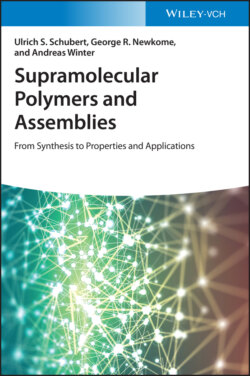Supramolecular Polymers and Assemblies

Реклама. ООО «ЛитРес», ИНН: 7719571260.
Оглавление
Andreas Winter. Supramolecular Polymers and Assemblies
Table of Contents
List of Tables
List of Illustrations
Guide
Pages
Supramolecular Polymers and Assemblies. From Synthesis to Properties and Applications
Preface
Abbreviations
About the Authors
1 Supramolecular Polymers: General Considerations* 1.1 Introduction
1.2 Classification Schemes
1.3 Supramolecular Polymerization Mechanisms
1.3.1 Isodesmic Supramolecular Polymerization
1.3.2 Ring‐Chain‐Mediated Supramolecular Polymerization
1.3.3 (Anti)‐cooperative Supramolecular Polymerization
1.4 Beyond Classical Supramolecular Polymerization
1.5 Concluding Remarks
References
Note
2 Supramolecular Assemblies Based on Ionic Interactions. 2.1 General Aspects
2.2 Basic Binding Modes and Discrete Model Assemblies
2.3 Supramolecular Polymers, Based on Ionic Interactions
2.3.1 Ionic Interactions, as Integral Part of the Polymer Backbone
2.3.1.1 Polymers, as Building Blocks
2.3.1.2 Small Molecules, as Building Blocks
2.3.2 Polymers Featuring Ionic Interactions in the Side Chain
2.3.3 Self‐assembly of Polyelectrolytes: Toward Polyelectrolyte Complexes
2.4 Concluding Remarks
References
3 Supramolecular Polymers, Based on Hydrogen‐Bonding Interactions*
3.1 General Aspects
3.2 From H‐Bonding Interactions to Supramolecular Polymers
3.2.1 Supramolecular Polymers, Based on Single H‐Bonding Interactions
3.2.2 Supramolecular Polymers, Based on Double H‐Bonding Interactions
3.2.3 Supramolecular Polymers, Based on Triple H‐Bonding Interactions
3.2.4 Supramolecular Polymers, Based on Quadruple H‐Bonding Interactions
3.2.5 Supramolecular Polymers, Based on Sextuple H‐Bonding Interactions
3.2.6 Supramolecular Polymers, Based on Multiple H‐Bonding Interactions
3.3 Conclusion Remarks
References
Note
4 Supramolecular Polymers, Based on Metal‐to‐Ligand Interactions* 4.1 General Aspects
4.2 Synthesis and Design Principles. 4.2.1 Metal‐Binding Sites in Metallo‐supramolecular Polymers
4.2.2 Synthesis of Metallo‐supramolecular Polymers
4.3 Linear Metallo‐supramolecular Polymers
4.3.1 Metallo‐supramolecular Polymers, Based on Coordinative Bonding
4.3.1.1 Metallopolymers Containing Ditopic Monodentate Ligands
4.3.1.2 Coordination Polymers Containing Ditopic Bidentate Ligands
4.3.1.3 Coordination Polymers Containing Ditopic Tridentate Ligands
4.3.2 Metallo‐supramolecular Polymers, Based on Covalent/Ionic Bonding
4.3.3 Metallo‐supramolecular Polymers Based on Metal–Arene Interactions
4.4 Concluding Remarks
References
Note
5 Supramolecular Polymers, Based on π‐Electronic Interactions. 5.1 General Aspects
5.2 Columnar Supramolecular Polymers, Based on π–π Stacking Interactions
5.3 From π–π Stacking to Advanced Donor–Acceptor‐Type Charge–Transfer Interactions
5.4 From Charge–Transfer to π‐Electronic Ion‐Pairing Interactions
5.5 Linear Supramolecular Polymers, Based on π‐Electronic Interactions
5.6 Conclusion and Outlook
References
6 Supramolecular Polymers, Based on Crown Ether Recognition. 6.1 General Aspects
6.2 From Crown Ether Molecular Recognition Toward Supramolecular Polymers
6.2.1 Linear Polypseudorotaxanes, Derived from Small‐Molecule Building Blocks
6.2.2 Linear Supramolecular Polymers Derived from Macromolecular Building Blocks
6.2.3 Dendritic, Hyperbranched, Star‐shaped, and Grafted Assemblies
6.3 Mechanical Interlocking: From Pseudorotaxanes to Rotaxanes
6.4 Poly(pseudo)rotaxanes, Derived from Preformed Polymers
6.5 Supramolecular Amphiphiles
6.6 Concluding Remarks
References
7 Supramolecular Polymers, Based on Cucurbiturils. 7.1 General Aspects
7.2 Interactions of CB[n]s with Small Organic Guest Molecules
7.3 Supramolecular Polymers Incorporating CB[n] Units
7.3.1 Supramolecular Polymers, Based on Small Organic Molecules
7.3.2 Supramolecular Polymers Incorporating (Bio)macromolecular Building Blocks
7.4 Concluding Remarks
References
8 Supramolecular Polymers, Based on the Host–Guest Chemistry of Calixarenes. 8.1 General Aspects
8.2 Calixarene‐Based Supramolecular Polycaps
8.3 Supramolecular Polymers Featuring Vacant Calixarene Scaffolds
8.4 Supramolecular Polymers, Formed by Host–Guest Interactions
8.4.1 Supramolecular Polymers, Derived from AB‐Type Monomers
8.4.2 Supramolecular Polymers, Derived from AA‐ and BB‐Type Monomers
8.5 Beyond Classical Calix[n]arenes: Calix[4]pyrroles
8.6 Miscellaneous Supramacromolecular Assemblies, Based on Calixarenes
8.7 Concluding Remarks
References
9 Cyclodextrins in the Field of Supramolecular Polymers. 9.1 General Aspects
9.2 Cyclodextrins and Supramolecular Polymers
9.2.1 Linear Polypseudorotaxanes, Derived from Preformed Linear Polymers
9.2.1.1 Polypseudorotaxanes from of Poly(ethylene Glycol)
9.2.1.2 Polypseudorotaxanes from Other Polyethers
9.2.1.3 Polypseudorotaxanes from Polyesters
9.2.1.4 Polypseudorotaxanes from Polyamides and Polyurethanes
9.2.1.5 Polypseudorotaxanes from Polyolefins
9.2.1.6 Polyrotaxanes from Inorganic Polymers
9.2.1.7 Polypseudorotaxanes from Conductive/Conjugated Polymers
9.2.1.8 Polypseudorotaxanes from Polyamines
9.2.2 Polypseudorotaxanes, Derived from Other Polymeric Architectures
9.2.2.1 Site‐Selective Complexation of Linear Block Copolymers
9.2.2.2 Polypseudorotaxanes from Star‐Shaped Polymers
9.2.2.3 Polypseudorotaxanes from Side‐Chain Polymers
9.3 End‐Capping: From Polypseudorotaxanes to Polyrotaxanes
9.4 Polymerization of Pre‐assembled Pseudorotaxanes
9.5 Supramolecular Polymerization, Based on CD Recognition
9.5.1 Supramolecular Polymerization of AB‐Type Monomers
9.5.2 Supramolecular Polymers, Derived from AA‐ and BB‐Type Monomers
9.5.3 Supramolecular Polymers, Derived from AA‐Type Monomers and CDs
9.6 Amphiphilic Supramolecular Diblock Copolymers
9.7 Concluding Remarks
References
10 Supramolecular Polymers, Based on the Host–Guest Chemistry of Pillarenes. 10.1 General Aspects
10.2 Host–Guest Complexation Between Pillarenes and Linear Polymers
10.3 Supramolecular Polymers, Derived from Pillarene‐based Host–Guest Interactions
10.4 Hyperbranched and Cross‐linked Assemblies
10.5 Supramolecular Assemblies, Based on Amphiphilic Pillar[5]arenes
10.6 Concluding Remarks
References
11 Supramolecular Polymers, Formed by Orthogonal Non‐covalent Interactions* 11.1 Introduction
11.2 Orthogonal Combinations of Supramolecular Interactions Involving Metal‐to‐Ligand Coordination
11.3 Orthogonal Combinations of Supramolecular Interactions Involving H-Bonding
11.4 Miscellaneous Orthogonal Combinations of Supramolecular Interactions
11.5 Biomimetic Orthogonal Self‐Assembly: Protein Recognition
11.6 Concluding Remarks
References
Note
12 Characterization of Supramolecular Polymers* 12.1 Introduction
12.2 Estimation of the Molar Mass from the Theories of Supramolecular Polymer Science
12.3 Size‐Exclusion Chromatography
12.4 Viscometry
12.5 Light Scattering
12.6 Vapor Pressure Osmometry
12.7 Analytical Ultracentrifugation
12.8 NMR Spectroscopy
12.9 Mass Spectrometry
12.10 Microscopy Imaging
12.10.1 Scanning Probe Microscopy
12.10.2 Electron Microscopy
12.11 Small/Wide‐Angle X‐Ray Scattering
12.12 X‐Ray Crystallography
12.13 Small‐Angle Neutron Scattering
12.14 Asymmetric Flow Field‐Flow Fractionation
12.15 Taylor Dispersion Analysis
12.16 They Are Very Complex Structures but Totally Timely …
References
Note
Index. a
b
c
d
e
f
g
h
i
j
l
m
n
o
p
q
r
s
t
u
v
w
x
z
WILEY END USER LICENSE AGREEMENT
Отрывок из книги
Ulrich S. Schubert George R. Newkome Andreas Winter
In the 1960s, supramolecular polymers were created in which two or more ions or molecules are held together by non‐covalent interactions, such as ionic/Coulombic, hydrogen‐bonding, and π–π‐stacking interactions as well as metal‐to‐ligand coordination. A wide, diverse group of host–guest (inclusion) complexes was named in this context. Despite their chemically, highly different nature, they offer common characteristics, such as the unique ability to assemble linear polymer chains due to the mostly high directionality of these interactions and, even more importantly, their reversibility of binding. Thus, when incorporated into a polymer backbone, materials are obtained that exhibit properties that cannot be realized by traditional, i.e. covalent polymers.
.....
Jena & Jupiter
Figure 1.1 Schematic representation of a polymer based on non‐covalent interactions.
.....